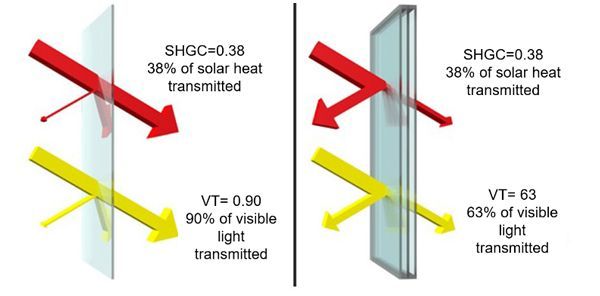November 14, 2023
Window Efficiency: What’s it all about?
We like windows in our homes. Windows provide some curb appeal, they let light into our homes, and they make us feel closer to the outdoors and nature. Windows can either be energy hogs or they can be very energy efficient. Window ratings tell us how much conductive heat, radiant heat and visible light is being transferred into our homes. Let’s try to understand the meaning of the three rating numbers.
Windows have two values that represent heat transfer and one value that represents light transfer. U-value and the SHGC (solar heat gain coefficient) represent heat transfer and VT (visible light transmittance) represents light transfer. The U-value measures how effective a material is as an insulator, resisting the flow of conductive heat. The SHGC is a measure of how much of the sun’s rays comes through the glass heating objects in the home. In both cases, the lower the number, the better. In simplistic terms, a U-value of 1.0 means that the material has no resistance and 100% of the heat is transferred through the Material – think of a frying pan on a hot plate. If the U-value is 0.5, 50% of the energy is transferred across the material.
Preventing radiant heat through windows is most important when it comes to keeping air conditioning costs low. All windows let in a certain amount of radiant heat. Radiant heat is the heat you feel when standing in front of a bonfire on a cold day. If there is nothing between you and the fire, you can feel the heat. As soon as another person stands between you and the fire, the radiant heat is blocked, and the other person is getting of all the heat.
Windows allow the radiant heat to come into the home and heat up items such as tables, chairs, all other furniture and additional objects in the room. These items are storage devices for heat and begin to radiate heat back to the occupants in the home. Windows with the right coating can reflect most of the radiant heat back outdoors before it can enter the inside of the home.
Energy efficient window coatings, known as low-e, are performance rated by the amount of radiant energy passing through the glass. The rating is known as the solar heat gain coefficient (SHGC). The SHGC can go from 1 to 0. Single pane clear glass has a SHGC of 0.87 with 87% of the radiant heat entering the home through the glass. An SHGC of 0.19 only lets 19% of the radiant energy through the glass.
The advantage of low SHGC window values show up in HVAC load calculations. For example, take a house that is 1,789 square feet with only 11% glass to floor area, which is relatively small. If the home has standard clear glass with an SHGC of .76 the HVAC load is 30,545 BTU/h (2.54-tons). If The exact same house had low-e windows with an average SHGC of .20 then HVAC load would drop to 24,065 BTU/h (2.01-tons). This is 21% decrease in the HVAC load for the same house with the same size windows, only the windows are low-e.

Windows also are measured by their visible light transmittance (VT). Windows are meant to allow light to enter our homes and enable us to view the outdoors. If coatings are dark, it will defeat that purpose. The VT rating is much like the SHGC, a VT of 1 allows 100% of the light to enter and a VT of .25 allows only 25% of the light in. Today’s low-e coatings are very efficient and will let as much as 70% of the visible light to enter the building while controlling the heat transfer.
Conclusion:
The three ratings; the U-value, the SHGC and the VT are all very important, but the SHGC is at the top of the list, followed by the VT and then the U-value is the least important. The U-value is the inverse of an R-value and the reason it is the least important of the three is because the temperature between outdoor and indoor in Southwest Florida is only about twenty degrees during the cooling season, given the mild winters. In heating dominated climates the temperature difference can be ninety degrees or more so getting the lowest U-value possible in northern climates is very important, however not so important in Southwest Florida.
The SHGC is very important in southern climates because it prevents the radiant heat from entering the home. As mentioned above, chairs, tables, couches, and other objects are all energy storage devices. Radiant heat enters through windows and heats these storage devices up which radiates heat back to the occupants in the space making them uncomfortable. If the sun’s rays can be prevented from entering through windows, the items in our homes will not make us uncomfortable. In sum, in southern climates we want the SHGC rating number to be as low as possible.
The VT or visible light transmittance, is important because even though we want to keep the radiant heat out, we want the light to come in. Tinted windows fail to meet this need, along with blocking some of the sun’s rays, tint also blocks light. Low-e coatings on the other hand offer the most visible light along with reflecting back to outdoors most of the radiant heat.

